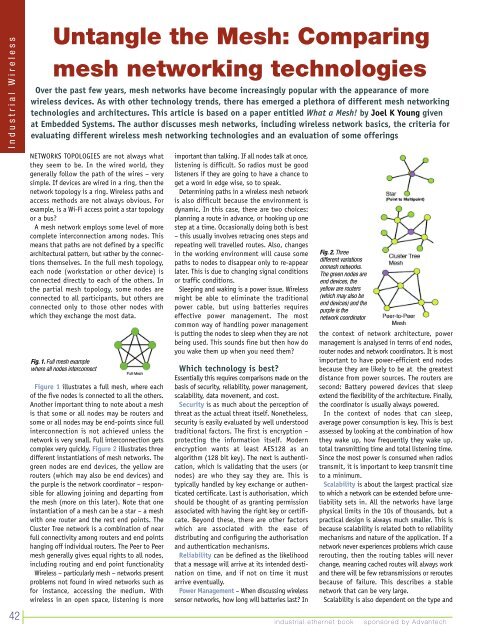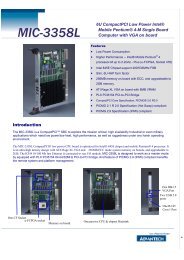industrial wireless book special edition - Networking ...
industrial wireless book special edition - Networking ...
industrial wireless book special edition - Networking ...
Create successful ePaper yourself
Turn your PDF publications into a flip-book with our unique Google optimized e-Paper software.
I n d u s t r i a l W i r e l e s s<br />
42<br />
Untangle the Mesh: Comparing<br />
mesh networking technologies<br />
Over the past few years, mesh networks have become increasingly popular with the appearance of more<br />
<strong>wireless</strong> devices. As with other technology trends, there has emerged a plethora of different mesh networking<br />
technologies and architectures. This article is based on a paper entitled What a Mesh! by Joel K Young given<br />
at Embedded Systems. The author discusses mesh networks, including <strong>wireless</strong> network basics, the criteria for<br />
evaluating different <strong>wireless</strong> mesh networking technologies and an evaluation of some offerings<br />
NETWORKS TOPOLOGIES are not always what<br />
they seem to be. In the wired world, they<br />
generally follow the path of the wires – very<br />
simple. If devices are wired in a ring, then the<br />
network topology is a ring. Wireless paths and<br />
access methods are not always obvious. For<br />
example, is a Wi-Fi access point a star topology<br />
or a bus?<br />
A mesh network employs some level of more<br />
complete interconnection among nodes. This<br />
means that paths are not defined by a specific<br />
architectural pattern, but rather by the connections<br />
themselves. In the full mesh topology,<br />
each node (workstation or other device) is<br />
connected directly to each of the others. In<br />
the partial mesh topology, some nodes are<br />
connected to all participants, but others are<br />
connected only to those other nodes with<br />
which they exchange the most data.<br />
Fig. 1. Full mesh example<br />
where all nodes interconnect<br />
Figure 1 illustrates a full mesh, where each<br />
of the five nodes is connected to all the others.<br />
Another important thing to note about a mesh<br />
is that some or all nodes may be routers and<br />
some or all nodes may be end-points since full<br />
interconnection is not achieved unless the<br />
network is very small. Full interconnection gets<br />
complex very quickly. Figure 2 illustrates three<br />
different instantiations of mesh networks. The<br />
green nodes are end devices, the yellow are<br />
routers (which may also be end devices) and<br />
the purple is the network coordinator – responsible<br />
for allowing joining and departing from<br />
the mesh (more on this later). Note that one<br />
instantiation of a mesh can be a star – a mesh<br />
with one router and the rest end points. The<br />
Cluster Tree network is a combination of near<br />
full connectivity among routers and end points<br />
hanging off individual routers. The Peer to Peer<br />
mesh generally gives equal rights to all nodes,<br />
including routing and end point functionality<br />
Wireless – particularly mesh – networks present<br />
problems not found in wired networks such as<br />
for instance, accessing the medium. With<br />
<strong>wireless</strong> in an open space, listening is more<br />
important than talking. If all nodes talk at once,<br />
listening is difficult. So radios must be good<br />
listeners if they are going to have a chance to<br />
get a word in edge wise, so to speak.<br />
Determining paths in a <strong>wireless</strong> mesh network<br />
is also difficult because the environment is<br />
dynamic. In this case, there are two choices:<br />
planning a route in advance, or hooking up one<br />
step at a time. Occasionally doing both is best<br />
– this usually involves retracing ones steps and<br />
repeating well travelled routes. Also, changes<br />
in the working environment will cause some<br />
paths to nodes to disappear only to re-appear<br />
later. This is due to changing signal conditions<br />
or traffic conditions.<br />
Sleeping and waking is a power issue. Wireless<br />
might be able to eliminate the traditional<br />
power cable, but using batteries requires<br />
effective power management. The most<br />
common way of handling power management<br />
is putting the nodes to sleep when they are not<br />
being used. This sounds fine but then how do<br />
you wake them up when you need them?<br />
Which technology is best?<br />
Essentially this requires comparisons made on the<br />
basis of security, reliability, power management,<br />
scalability, data movement, and cost.<br />
Security is as much about the perception of<br />
threat as the actual threat itself. Nonetheless,<br />
security is easily evaluated by well understood<br />
traditional factors. The first is encryption –<br />
protecting the information itself. Modern<br />
encryption wants at least AES128 as an<br />
algorithm (128 bit key). The next is authentication,<br />
which is validating that the users (or<br />
nodes) are who they say they are. This is<br />
typically handled by key exchange or authenticated<br />
certificate. Last is authorisation, which<br />
should be thought of as granting permission<br />
associated with having the right key or certificate.<br />
Beyond these, there are other factors<br />
which are associated with the ease of<br />
distributing and configuring the authorisation<br />
and authentication mechanisms.<br />
Reliability can be defined as the likelihood<br />
that a message will arrive at its intended destination<br />
on time, and if not on time it must<br />
arrive eventually.<br />
Power Management – When discussing <strong>wireless</strong><br />
sensor networks, how long will batteries last? In<br />
Fig. 2. Three<br />
different variations<br />
onmesh networks.<br />
The green nodes are<br />
end devices, the<br />
yellow are routers<br />
(which may also be<br />
end devices) and the<br />
purple is the<br />
network coordinator<br />
<strong>industrial</strong> ethernet <strong>book</strong><br />
the context of network architecture, power<br />
management is analysed in terms of end nodes,<br />
router nodes and network coordinators. It is most<br />
important to have power-efficient end nodes<br />
because they are likely to be at the greatest<br />
distance from power sources. The routers are<br />
second: Battery powered devices that sleep<br />
extend the flexibility of the architecture. Finally,<br />
the coordinator is usually always powered.<br />
In the context of nodes that can sleep,<br />
average power consumption is key. This is best<br />
assessed by looking at the combination of how<br />
they wake up, how frequently they wake up,<br />
total transmitting time and total listening time.<br />
Since the most power is consumed when radios<br />
transmit, it is important to keep transmit time<br />
to a minimum.<br />
Scalability is about the largest practical size<br />
to which a network can be extended before unreliability<br />
sets in. All the networks have large<br />
physical limits in the 10s of thousands, but a<br />
practical design is always much smaller. This is<br />
because scalability is related both to reliability<br />
mechanisms and nature of the application. If a<br />
network never experiences problems which cause<br />
rerouting, then the routing tables will never<br />
change, meaning cached routes will always work<br />
and there will be few retransmissions or reroutes<br />
because of failure. This describes a stable<br />
network that can be very large.<br />
Scalability is also dependent on the type and<br />
sponsored by Advantech

















